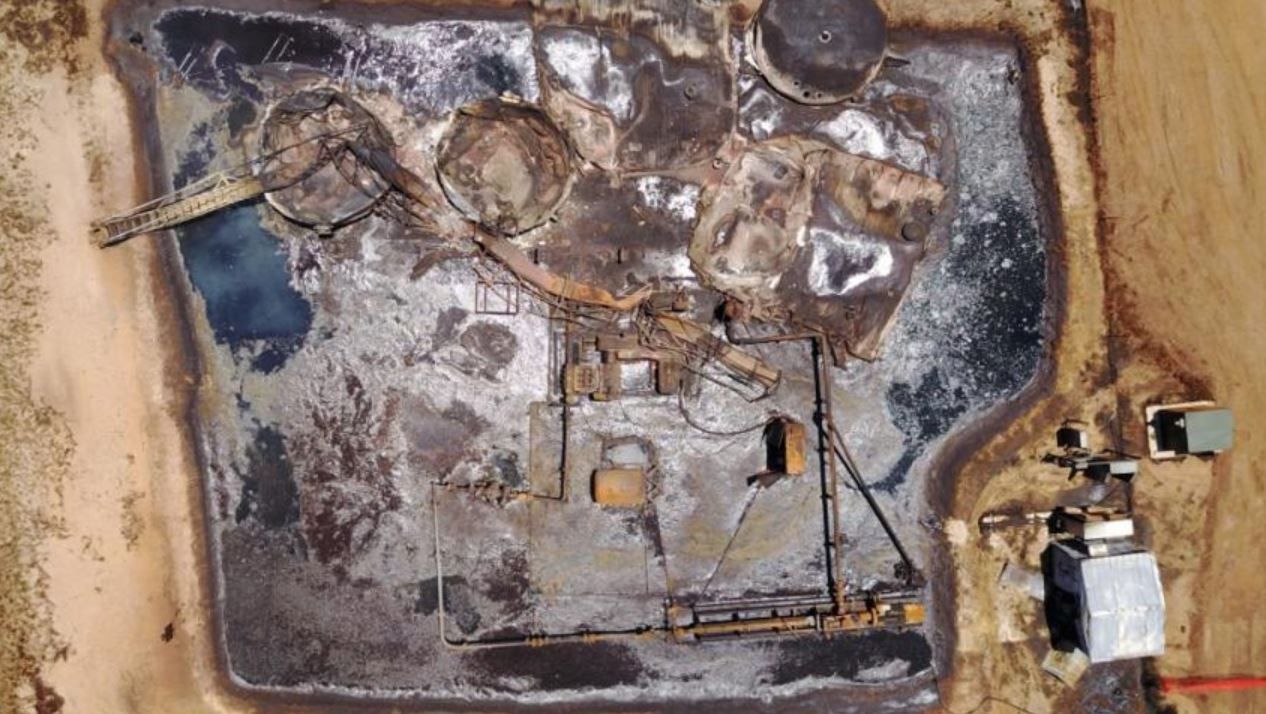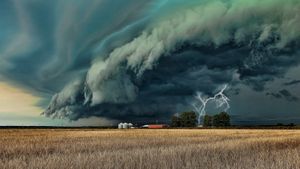Many SWD fires are ignited by lightning. We all know that, but why? Most importantly, is SWD just begging for trouble?
In the early hours of the morning on June 18, 2019, few drivers on Texas State Hwy 17 reported a fire at an industrial site. A video was recorded and uploaded to YouTube showing a thick column of black smoke which could be seen for miles while 16 tanks holding oilfield wastewater were burning. Volunteer firefighters from six fire departments responded and spent more than seven hours trying to extinguish the flames.
The fire and explosions engulfed the whole facility and rendered all property unsalvageable.
Local news reports noted, as if in explanation, that a lightning stroke hit the saltwater disposal (a.k.a. SWD) facility.
Lightning can prove to be a spectacular sight for some, but for the oil and gas industry, it can infuse worry and oftentimes, property destruction. One repeated victim, threatening to become so frequent as to appear mundane, are SWD facilities.
If it ignites a fire within the tank battery, it’s quite likely that it will start a massive blaze. Fire often go undetected in their early stages. But once ignited, chaos quickly ensues; it quickly spreads to neighboring tanks and temperatures rise to hellish levels and spreads outwards. In some cases, the tank lids themselves fly like frisbees or even the tanks are propelled up in the air like a heavy rockets. The whole tank battery is usually lost after few hours, spilling oil and produced water.

When you tally the number of claims in this market, I’m guilty as the next to think that property losses due to lightning are inevitable. There is no doubt that lightning is the major culprit. That leads to a tantalizing question: What makes lightning so dangerous? I can’t here demonstrate in any practical fashion all the engineering, but let me give it a nontechnical, nonscientific try.
For the sake of clarity, lightning is a common atmospheric electricity phenomenon. It starts with the slow movement and charge transfer inside storm clouds, building an electrostatic field over a large area. This also induces a field of opposite charge on the surface of the earth beneath it, with a relatively small current flow that causes no material damage. This charge differential is periodically neutralized almost instantaneously by a lightning stroke.
While we are here:
A complete lightning discharge is called a flash. About 2/3’s stays in the cloud; the other 1/3 makes its way to land. Each cloud-to-ground flash is composed of ~3-4 lightning strokes (but may have as many as 30), 90% of which are negatively charged. Most lightning occurs in the summer months and between 2:00 pm and 8:00 pm.
According to the smart folks of Vaisala, there were 216,978,014 lightning events recorded in the U.S. in 2019 – that’s nearly a quarter of a billion (globally there were 2.35 billion). To make matters worse, the energy-producing States top the charts. The first place was for Texas with 47 million lightning events, tripling up northern neighbor Oklahoma’s second place finish with 14.7 million. Several factors, including latitude, relative humidity, and proximity to large bodies of water — as well as the sheer land mass of 696,200 km2 — align to make Texas an annual contender for the top of this list. The two states north of Texas, Oklahoma and Kansas, also have large total lightning counts due to active storm systems that often form there. North Dakota was a distant 23rd on the list with 3.2 million occurrences.
It is hard to estimate the energy released by a lightning flash, but a typical range is about 109 to 1010 Joules, which is equivalent to the energy required to power a regular light bulb for 4 months. The currents in any one stroke can range from just a few kilo amperes (kA) to over 200 kA. With a temperature of ~30,000 Kelvin (~53,500 °F), you may be flummoxed to know that lightning is five times hotter than the surface of the sun.
The final striking location is determined at the instant when the lightning channel is about 30-50 meters above the ground. It hits the highest vertical electric field region, usually at the tallest structure. For a typical far-from-everything-else SWD facility, this is usually an object on top or around a tank top, such as a tank thief hatch, a gauge pole, a light, or a handrail. As the current is spread across multiple pads, the surface charge is neutralized.
Most people would imagine that if lightning strikes an earthed metal structure, such as a lightning conductor, then all should be well. That's far from the truth: any conducting circuit experiments something called "inductance", which can never be fully removed.
Inductance is a property of any conductor to resists any variation in the current passing through it by generating a back magnetic field. The magnitude of the field depends on the strength of the current. For example, it was common practice in medieval Europe to store gunpowder in the local church tower because this was usually the only stone-built and secure building for miles around. Records show that a few of these disappeared with a bang during thunderstorms. Of course, there were other more dangerous places.

A typical stroke will inject current into a circuit at a rate of about 10 KA/ms, which will manifest in a huge voltage spike. In the case of the church towers, excessive currents flowing down wet stonework created their own magnetic fields, and the electromotive forces induced in nearby metalwork could easily create a spark.
The same principles apply on tank farms, or in this case, SWD facilities. Even indirect strikes can become an ignition source in the presence of a "discontinuity" or gap. Discontinuities cause serious trouble because at very high voltages, the air in between ionises and the current flow persists, which may result in an electric spark (and “electric spark”, you have to admit, is a spectacular term for “arc”).

Which brings me, somewhat circuitously, to something that I perhaps don’t have to remind you, but will anyway: Lightning is an unavoidable ignition source.
But operating SWD isn’t just begging for trouble. Hundreds of such facilities are often hit by strokes and do not budge. Most times, a lightning-generated fire is a feckless little namby-pamby freestanding excuse for a gap in managing risk. With proper engineering, equipment, and practices, static electricity can rapidly drain away to earth safely. But a crucial, crucial thing about fire, no matter how it ignites: it needs oxygen and fuel.
The real reason why SWD fires occur is that a flammable material is available, either in the fiberglass tanks that are bonded with flammable resins, or within the vapor spaces inside tanks. Then again, the best source of fuel is the skim oil storage tank, which often lies adjacent to the other tanks, and shouldn’t be. Lightning can also result in electrical and electronic failure, truck fires, as well as communication and control equipment failure.
I hope that made you learn at least a thing or two. It should.
Share, follow, stay tuned for more!

